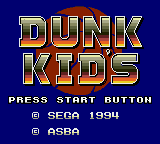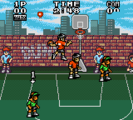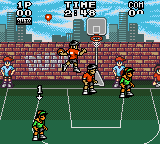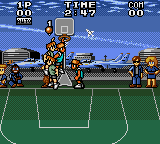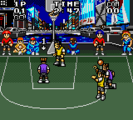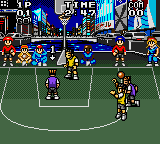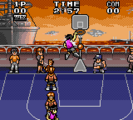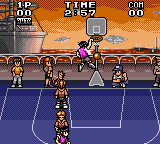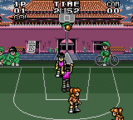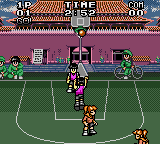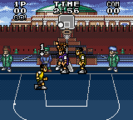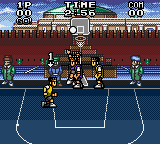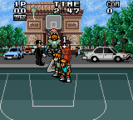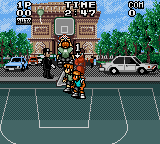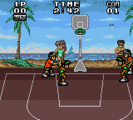Difference between revisions of "Dunk Kids"
From Sega Retro
(added OmniBox) |
(added note about ASBA) |
||
| Line 15: | Line 15: | ||
}} | }} | ||
'''''Dunk Kids''''' (ダンクキッズ) (spelled with an apostrophe as '''''Dunk Kid's''''') is a [[Sega Game Gear]] half-court basketball game developed by [[I.T.L]] and published by [[Sega]]. Released exclusively in Japan in September 1994, the game utilizes the [[Gear-to-Gear Cable]] for local multiplayer. | '''''Dunk Kids''''' (ダンクキッズ) (spelled with an apostrophe as '''''Dunk Kid's''''') is a [[Sega Game Gear]] half-court basketball game developed by [[I.T.L]] and published by [[Sega]]. Released exclusively in Japan in September 1994, the game utilizes the [[Gear-to-Gear Cable]] for local multiplayer. | ||
| + | |||
| + | The game claims to be licensed by the All-Japan Street Basketball Association (ASBA), though it is not clear if this was a real league or something invented for the game. | ||
==Gameplay== | ==Gameplay== | ||
| Line 21: | Line 23: | ||
When playing defense, the player can steal the ball from an opponent when close with {{1}} or jump to try and block a shot with {{2}}. The defending player is charged with balltending if the player touches the ball when it is above the basket, which gives the offensive team points for the shot. | When playing defense, the player can steal the ball from an opponent when close with {{1}} or jump to try and block a shot with {{2}}. The defending player is charged with balltending if the player touches the ball when it is above the basket, which gives the offensive team points for the shot. | ||
| − | When playing offense, the player dribbles the ball by holding {{1}}, passes by pressing {{1}}, and shoots with {{2}}. The player automatically has control of the | + | When playing offense, the player dribbles the ball by holding {{1}}, passes by pressing {{1}}, and shoots with {{2}}. The player automatically has control of the team member who possesses the ball. The player must dribble to move with the ball to avoid traveling. Opponents can intercept balls as they are being passed. |
There is a tournament mode where the player chooses one of the four Japanese teams and faces the other teams in order of increasing difficulty (with the other three Japanese teams being the easiest). In this mode, each match is three minutes long, and the team with the highest score at the end of the period wins. There is also a free play mode where the player can choose to play as any of the eight teams and also selects the opposing team. Free play matches can be played with a time limit (which is selectable), or players can compete to attain a certain score. | There is a tournament mode where the player chooses one of the four Japanese teams and faces the other teams in order of increasing difficulty (with the other three Japanese teams being the easiest). In this mode, each match is three minutes long, and the team with the highest score at the end of the period wins. There is also a free play mode where the player can choose to play as any of the eight teams and also selects the opposing team. Free play matches can be played with a time limit (which is selectable), or players can compete to attain a certain score. | ||
| Line 38: | Line 40: | ||
===Courts=== | ===Courts=== | ||
| + | The Okinawa court appears to be located in an [[wikipedia:United States Forces Japan|American military base]]. The Europe court takes place in front of the Arc de Triomphe in Paris. | ||
| + | |||
{{gallery|widths=160|screens=yes| | {{gallery|widths=160|screens=yes| | ||
{{gitem|Dunk Kids, Stages, Tokyo.png|Tokyo}} | {{gitem|Dunk Kids, Stages, Tokyo.png|Tokyo}} | ||
Revision as of 09:37, 15 May 2022
| Dunk Kids | ||||||||||
|---|---|---|---|---|---|---|---|---|---|---|
| System(s): Sega Game Gear | ||||||||||
| Publisher: Sega[1] | ||||||||||
| Developer: I.T.L[1] | ||||||||||
| Peripherals supported: Gear-to-Gear Cable | ||||||||||
| Genre: Sports[2][3] | ||||||||||
| Number of players: 1-2 | ||||||||||
|
Dunk Kids (ダンクキッズ) (spelled with an apostrophe as Dunk Kid's) is a Sega Game Gear half-court basketball game developed by I.T.L and published by Sega. Released exclusively in Japan in September 1994, the game utilizes the Gear-to-Gear Cable for local multiplayer.
The game claims to be licensed by the All-Japan Street Basketball Association (ASBA), though it is not clear if this was a real league or something invented for the game.
Contents
Gameplay
The game is a two-on-two basketball game played on a half-court with one basket. The goal is to score more baskets than the opposing team; baskets from within the key are worth one point, and baskets from outside the key are worth two points. Scoring from under the basket sometimes triggers a special dunk animation. The player can choose from one of eight teams, half of which are prefectures of Japan. Each team has different defense, speed, and shooting characteristics. The active team member is moved with the D-pad.
When playing defense, the player can steal the ball from an opponent when close with ![]() or jump to try and block a shot with
or jump to try and block a shot with ![]() . The defending player is charged with balltending if the player touches the ball when it is above the basket, which gives the offensive team points for the shot.
. The defending player is charged with balltending if the player touches the ball when it is above the basket, which gives the offensive team points for the shot.
When playing offense, the player dribbles the ball by holding ![]() , passes by pressing
, passes by pressing ![]() , and shoots with
, and shoots with ![]() . The player automatically has control of the team member who possesses the ball. The player must dribble to move with the ball to avoid traveling. Opponents can intercept balls as they are being passed.
. The player automatically has control of the team member who possesses the ball. The player must dribble to move with the ball to avoid traveling. Opponents can intercept balls as they are being passed.
There is a tournament mode where the player chooses one of the four Japanese teams and faces the other teams in order of increasing difficulty (with the other three Japanese teams being the easiest). In this mode, each match is three minutes long, and the team with the highest score at the end of the period wins. There is also a free play mode where the player can choose to play as any of the eight teams and also selects the opposing team. Free play matches can be played with a time limit (which is selectable), or players can compete to attain a certain score.
The game supports two-player play over a Gear-to-Gear Cable. Players can compete together against the AI, where each player controls a different team member, or they can compete against each other, with each player controlling a team of two players as in the single-player modes.
Teams
- Tokyo
- Okinawa
- Osaka
- Kanagawa
- China
- Russia
- Europe
- Hawaii
Courts
The Okinawa court appears to be located in an American military base. The Europe court takes place in front of the Arc de Triomphe in Paris.
Magazine articles
- Main article: Dunk Kids/Magazine articles.
Physical scans
| Sega Retro Average | ||||||||||||||
|---|---|---|---|---|---|---|---|---|---|---|---|---|---|---|
|
| 48 | |
|---|---|
| Based on 2 reviews | |
Technical information
ROM dump status
| System | Hash | Size | Build Date | Source | Comments | |||||||||
|---|---|---|---|---|---|---|---|---|---|---|---|---|---|---|
| ? |
|
512kB | Cartridge (JP) |
External links
- Dunk Kid's (Game Gear) article at Lunatic Obscurity
References
- ↑ 1.0 1.1 http://gdri.smspower.org/wiki/index.php/I.T.L
- ↑ File:DunkKids GG JP Box Front.jpg
- ↑ 3.0 3.1 https://sega.jp/history/hard/gamegear/software.html (Wayback Machine: 2018-12-07 04:57)
- ↑ Beep! MegaDrive, "September 1994" (JP; 1994-08-08), page 17
- ↑ Famitsu, "1994-09-02" (JP; 1994-08-19), page 40
| Dunk Kids | |
|---|---|
|
Main page | Magazine articles | Reception | |
